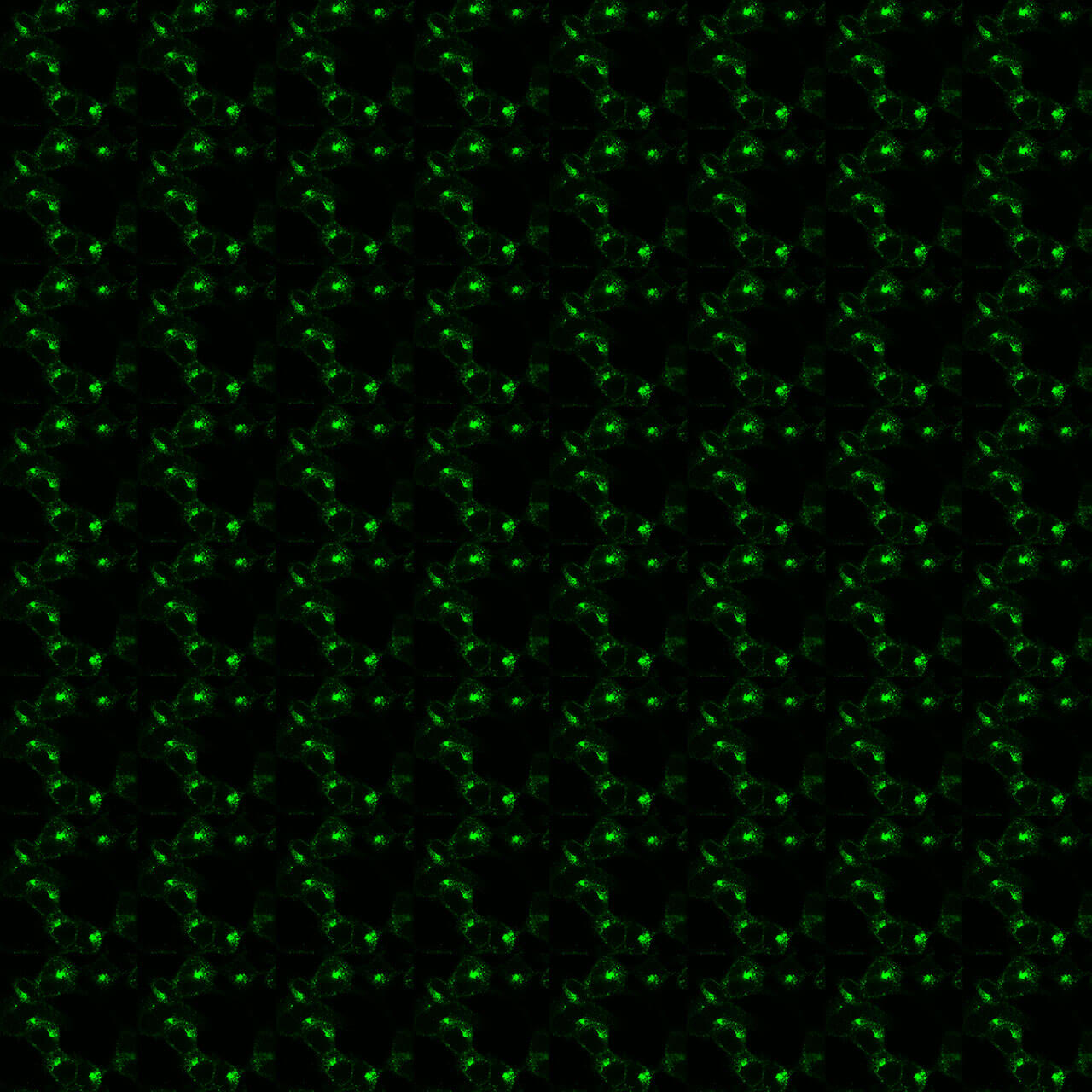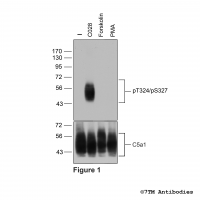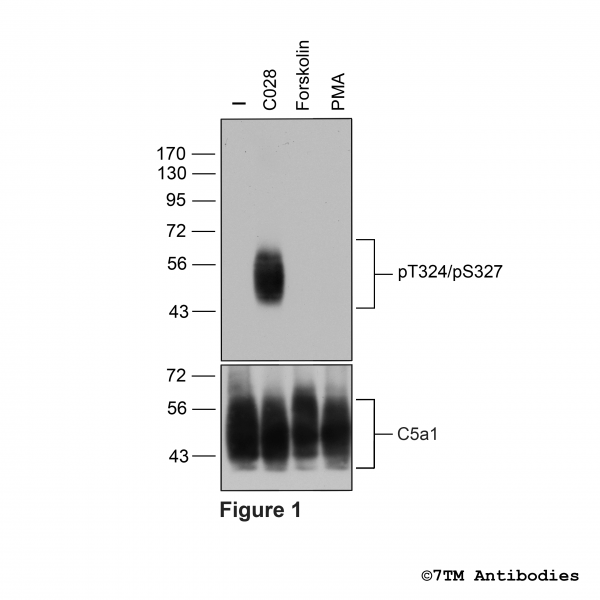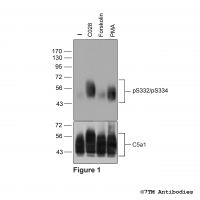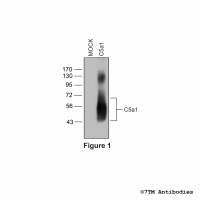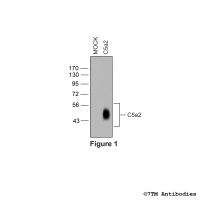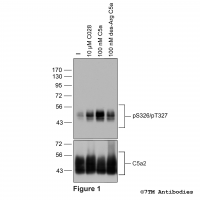Prices plus VAT plus shipping costs
Ready to ship today,
Delivery time appr. 5-8 days
- Order number: 7TM0032A
- Content: 100 µl
- Host: Rabbit
Threonine324/serine327 (T324/S327) is a major phosphorylation site of the C5a1 receptor. The pT324/pS327-C5a1 antibody detects phosphorylation in response to high- and low-efficacy agonists but not after PKC activation. T324/S327 phosphorylation is a key regulator of C5a1 desensitization, β-arrestin recruitment and internalization. The pT324/pS327-C5a1 antibody can by used for detection of the subcellular location of phosphorylated C5a1 receptors by immunocytochemistry.
| Alternative Names | C5a1, C5AR1, Complement C5a Receptor 1, C5a Anaphylatoxin Chemotactic Receptor 1 |
| IUPHAR Target ID | 32 |
| UniProt ID | P21730 |
| Western Blot (WB) | 1:1000 |
| Immunocytochemistry (ICC) | 1:200 |
| Species Reactivity | Human |
| Host / Isotype | Rabbit / IgG |
| Class | Polyclonal |
| Immunogen | A synthetic phosphopeptide derived from human C5a1 around the phosphorylation site of Thr324/Ser327 |
| Form | Liquid |
| Purification | Antigen affinity chromatography |
| Storage buffer | Dulbecco's PBS, pH 7.4, with 150 mM NaCl, 0.02% sodium azide |
| Storage conditions | short-term 4°C, long-term -20°C |
Figure 1. Agonist-induced Threonine324/Serine327 phosphorylation of the Complement C5a Receptor 1. Upper panel, HEK293 cells stably expressing the Complement C5a Receptor 1 (C5a1) were either not exposed or exposed to 1 µM specific Complement C5a receptor agonist CO28 or 10 μM Forskolin or 0.1 μM PMA (Phorbol 12-Myristate 13-Acetate) for 30 minutes. Cells were lysed and immunoblotted with the anti-pT324/pS327-C5a1 antibody (7TM0032A) at a dilution of 1:1000. Lower panel, blot was stripped and reprobed with the phosphorylation-independent anti-C5a1 antibody (7TM0032N-WB) at a dilution of 1:1000 to confirm equal loading of the gel.
Figure 2. Analysis of dose-dependent Complement C5a Receptor 1 phosphorylation using two phosphosite-specific antibodies. Upper two panels, HEK293 cells stably expressing the Complement C5a Receptor 1 (C5a1) were either not exposed or exposed to increasing concentrations of complement fragment C5a ranging from 1 nM to 100 nM for 30 minutes. Cells were lysed and immunoblotted with the anti-pT324/pS327-C5a1 antibody (7TM0032A) or anti-pS332/pS334-C5a1 antibody (7TM0032B) at a dilution of 1:1000. Lower panel, blot was stripped and reprobed with the phosphorylation-independent anti-C5a1 antibody (7TM0032N-WB) at a dilution of 1:1000 to confirm equal loading of the gel.
Figure 3. Analysis of agonist-dependent Complement C5a Receptor 1 phosphorylation using two phosphosite-specific antibodies. Upper two panels, HEK293 cells stably expressing the Complement C5a receptor 1 (C5a1) were either not exposed or exposed to 10 µM CO28 or 100 nM complement fragment C5a or 100 nM des-Arg C5a (C5a lacking the c-terminal arginine) for 30 minutes. Cells were lysed and immunoblotted with the anti-pT324/pS327-C5a1 antibody (7TM0032A) or anti-pS332/pS334-C5a1 antibody (7TM0032B) at a dilution of 1:1000. Lower panel, blot was stripped and reprobed with the phosphorylation-independent anti-C5a1 antibody (7TM0032N-WB) at a dilution of 1:1000 to confirm equal loading of the gel.
Figure 4. Immunocytochemical identification of Threonine324/Serine327 phosphorylation of the Complement C5a Receptor 1 in HEK293 cells. HEK293 cells stably expressing the Complement C5a Receptor 1 (C5a1) were either not exposed or exposed to 100 nM complement C5a and immunocytochemically stained with the anti-pT324/pS327-C5a1 antibody (7TM0032A) at a dilution of 1:200. Note, Threonine324/Serine327-phosphorylated C5a1 receptors were not detectable in untreated cells (0 min). Threonine324/Serine327-phosphorylated C5a1 receptors were seen as perinuclear clusters of vesicles after 30 min.
Be the first to decipher the C5a1 phosphorylation barcode and let us know.

